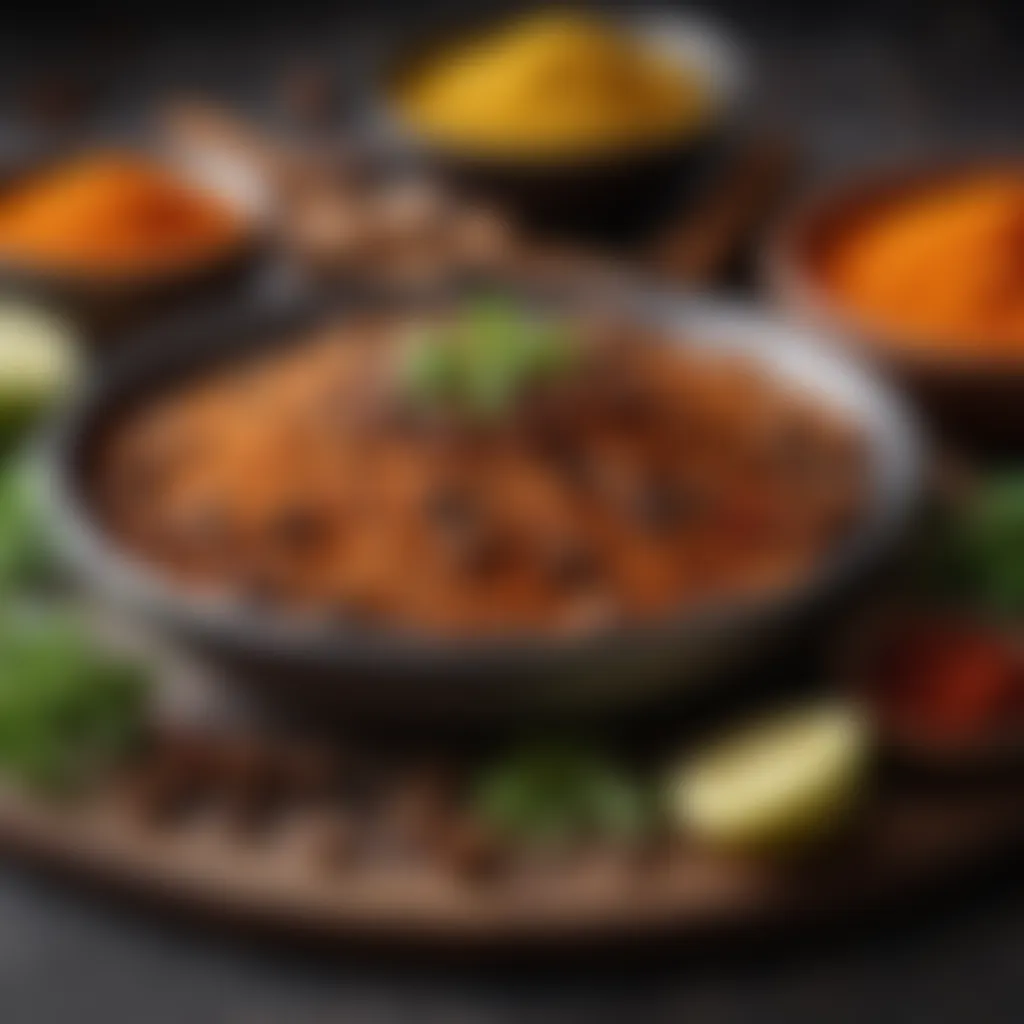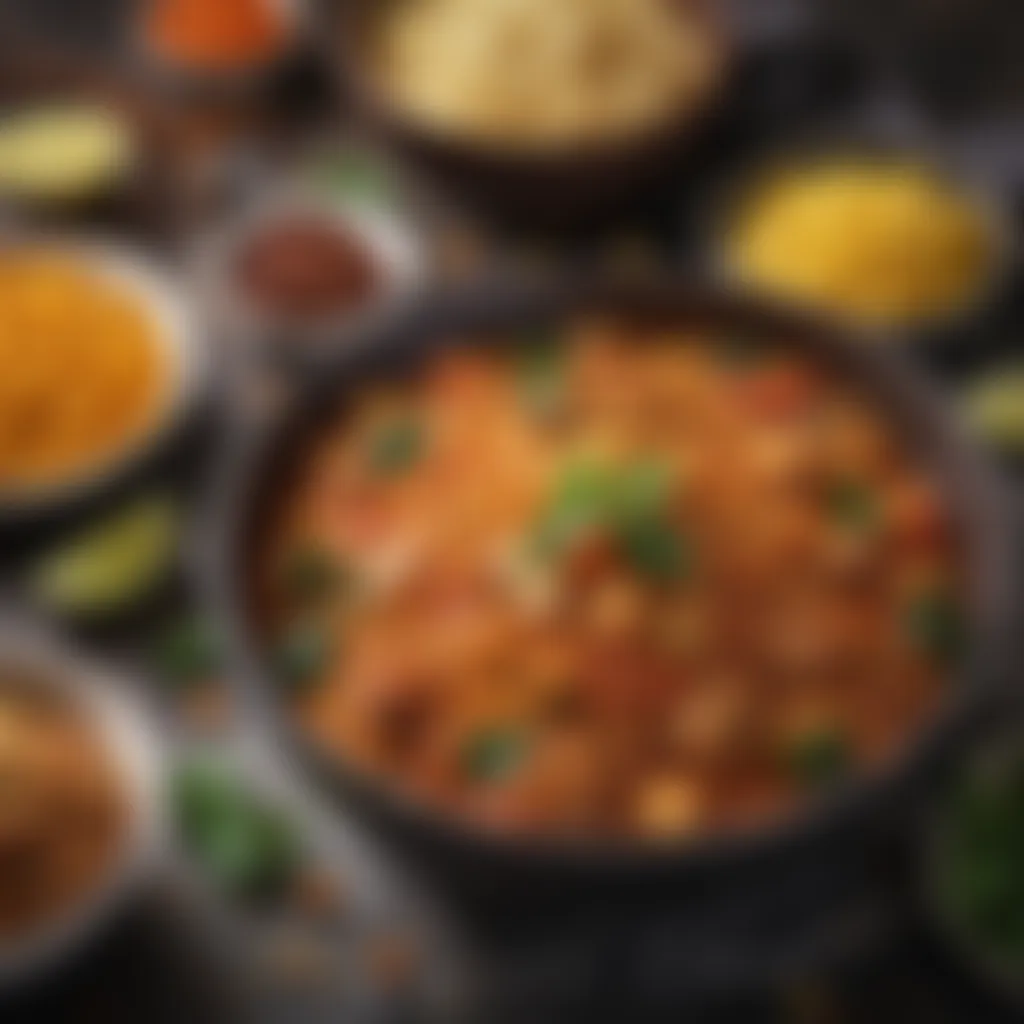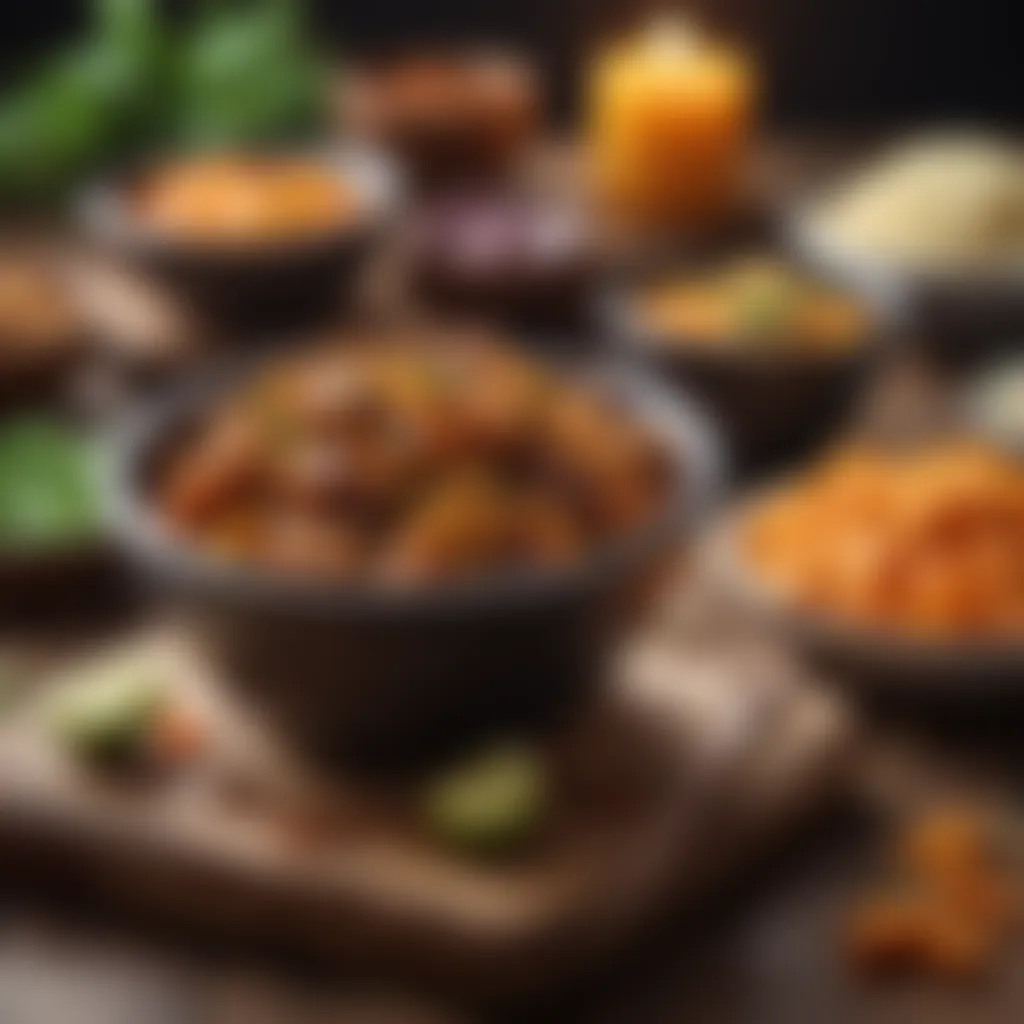Savor Authentic Mauritian Akni: A Culinary Journey


Intro
Mauritius, a paradise of sun-kissed beaches and vibrant cultures, brings together a mélange of flavors that reflect its rich heritage. Among the numerous culinary gems of this island nation is Akni, a dish that has woven its way into the hearts and homes of many Mauritian families. It’s not just food; it’s a celebration of culture, a testament to resilience, shared experiences, and the rolling waves of history that have shaped its identity.
Akni is often seen as a labor of love, passed down through generations, each family adding their own special twist to the original recipe. Whether it’s the joyous gatherings during festivals or cozy family dinners, Akni plays a pivotal role in creating memorable moments around the dining table. In this article, we’re going to explore the details of this traditional dish—from gathering the ingredients to savoring the final result, ensuring that you can recreate this Beloved Mauritian Staple in your own kitchen.
Let’s dive straight into the details, beginning with the essential ingredients.
Preface to Akni
Akni is not just another dish; it is a culinary emblem of Mauritius, weaving together flavors and stories that span generations. Understanding Akni is about more than just the preparation of its ingredients; it invites you to explore the cultural tapestry of this island nation, steeped in a rich history and a blend of diverse traditions. This section sets the stage for appreciating the significance of Akni, showcasing why it deserves a special place in both Mauritian kitchens and the hearts of food enthusiasts.
Historical Context
The roots of Akni can be traced back through the annals of Mauritius’s past, where various cultures—including Indian, African, and French—intertwined to form a unique gastronomic identity. It is believed that the dish originated from the Indian subcontinent, evolving over time as it mingled with local ingredients and practices. Historical accounts suggest that Akni was traditionally prepared by families during gatherings and ceremonies, marking it as a dish of camaraderie, unity, and celebration.
In essence, Akni serves as a reminder of the island’s diverse heritage, where each layer of flavor tells a story of migration, adaptation, and cultural blending.
Cooking Akni today means preserving these stories while adding new chapters through modern influence. Its creation is both an art and a rediscovery of history, reminding us how flavors can withstand the test of time yet still evolve into something contemporary.
Culinary Significance in Mauritius
In Mauritian households, Akni occupies a cherished spot at the dining table. It is not merely a meal; it symbolizes warmth, hospitality, and love—attributes integral to Mauritian culture. Family gatherings often revolve around this dish, echoing the sentiments of togetherness and joy.
- Flavorful Layers: The complexity of Akni, with its aromatic spices and carefully chosen ingredients, elevates it from simple sustenance to a sensory experience.
- Versatility: While traditionally made with meat and rice, Akni can be adapted to suit various dietary preferences, showcasing its ability to endure changing tastes and health trends.
Akni is often served during important occasions, from weddings to religious festivals, marking its place in significant life events. Whether it is shared among friends or family, this dish is a bridge connecting generations, enabling personal stories and collective memories to simmer together—much like its ingredients.
As we delve deeper into the wonderful realm of Akni, we will discover its essential ingredients and the meticulous preparation process that brings this dish to life. Prepare to explore what makes Akni a cornerstone of Mauritian cuisine!
Essential Ingredients
When one embarks on the journey to create the authentic Akni, understanding the essential ingredients isn't just a matter of preference; it's the cornerstone of transforming simple food into a masterpiece. Each element plays a crucial role, contributing not only to the flavor but also to the texture and aroma that define this dish. Using quality ingredients ensures that the final product resonates with the genuine taste of Mauritian culture.
Rice Varieties Used
Akni is predominantly made with basmati rice, known for its long grains and aromatic qualities. The cooking technique applied to basmati allows each grain to stay separate, which is vital for achieving that traditional fluffy texture. There are few options like jasmine rice which can be used, but nothing quite compares to the marriage of basmati and the spices that accompany it. It's worth noting that soaking the rice prior to cooking aids in reducing the cooking time and enhances the rice's final softness—an oft-overlooked step in the preparation process.
Meat and Protein Options
When it comes to meat, variety reigns supreme. Chicken, lamb, and beef are traditional choices, but what you opt for can shape the dish dramatically. For instance, mutton adds a rich flavor that could elevate your Akni to new heights, though it may require a bit more cooking to reach tenderness. Moreover, vegetarian options also find a welcoming home here, where chickpeas or even a medley of seasonal vegetables can replace meat. The key is to marinade your chosen protein with spices before cooking to infuse it with flavor.
Vegetables and Aromatics
Vegetables are not just fillers; they bring color and nutrients into the dish. Classic choices include carrots, peas, and potatoes. Each element contributes to a balanced dish by adding sweetness and texture. On the aromatic front, onions, garlic, ginger, and green chilies form the bedrock of flavor. Carefully sautéing these ingredients releases their natural oils, creating a base that enhances the entire dish. It’s remarkable how much depth can be added through well-cooked onions alone, turning sweetness into savory goodness.
Spices and Flavor Enhancers


The heart of Akni lies within its spices. Turmeric, cumin, and coriander are among the essentials, but don’t forget the magic of garam masala and cardamom for that warm, fragrant touch that can make anyone's mouth water. Each spice has a unique role to play; for example, turmeric not only adds vivid color but also carries health benefits. A balanced hand in using these spices is crucial—too much can overwhelm, while too little may leave it bland. The art is in the layering: sprinkle in some spices early and reserve others to add freshness at the end.
"The secret to a great Akni is not just in the ingredients used but in the careful balance and harmony achieved through preparation and cooking techniques."
Preparation Process
The preparation process is an essential element in crafting a dish as intricate as Akni. This stage not only sets the groundwork for the flavors to emerge but also ensures that every ingredient shines in its own right. A well-prepared Akni reflects the chef’s attention to detail, patience, and love for the culinary arts.
Throughout this section, we will explore the significance of properly preparing ingredients, the cooking techniques that make all the difference, and how layering flavors contributes to the ultimate enjoyment of the dish.
Preparing the Ingredients
First things first: the ingredients. Sourcing high-quality ingredients is the foundation of any great meal. When it comes to Akni, one cannot simply grab whatever is on hand; it’s vital to select the freshest components. This includes rice, which should ideally be a short or medium-grain variety, providing that sticky texture. Then, choose your meats and proteins wisely; whether it is chicken, lamb, or even seafood, the choice influences the final taste immensely.
Next, vegetables play a crucial role. Onions, carrots, and peas are common, but don’t forget to consider local options that might give the dish a unique twist. Preparation is also about cutting them properly – even slices can cook evenly and enhance the texture.
Lastly, spices and herbs should be measured out ahead to ensure a balanced flavor profile. Bay leaves, saffron, and garam masala are staples that evoke the essence of Mauritius.
Cooking Techniques Employed
Now let’s talk techniques. Cooking Akni is an art that requires both skill and mindfulness. One fundamental technique is sautéing, which involves cooking the meat and vegetables first. This not only helps to develop flavors but gives the dish depth. Browning the meat creates a beautiful fond at the bottom of the pot, which should not be overlooked. It’s the little bits that can make a world of difference.
Once everything is cooked slightly, layering comes into play. The rice acts as a barrier, absorbing all those flavors simmering below. This layered cooking method is akin to creating a stratified flavor profile. Instead of simply boiling or stirring, one must allow the rice to cook gently atop the seasoned meat and aromatic vegetables.
Layering the Flavors
Layering flavors is not just a technique; it’s the culmination of all the efforts put into preparing the Akni. The art of layering means that each ingredient gets the chance to express itself while blending seamlessly with others. Starting with a base of sautéed onions and spices, then following with layers of protein and vegetables offers a gradual infusion of taste.
When adding the rice, don’t just dump it in. Gently spread it across the top, almost like tucking it in. This ensures the rice cooks evenly and absorbs the rich broth below. Additionally, scattering saffron-infused water or stock throughout adds depth of flavor and a mesmerizing color.
Remember: The slow-cooking process is where the magic happens. Patience is key here. Letting the Akni cook over low heat allows the flavors to intermingle, creating a tapestry of taste that will be delightful in every bite.
Serving Suggestions
Understanding how to serve Akni goes much beyond just placing it on a plate. The way you present this culinary gem can elevate the dining experience and enhance its savoriness, making it a truly memorable meal. Serving suggestions not only reflect cultural nuances but also increase the dish's appeal to your guests or family. Let’s delve into some thoughtful accompaniments and presentation techniques that can complement this traditional Mauritian fare.
Traditional Accompaniments
In Mauritius, Akni is often paired with a variety of traditional accompaniments that enrich the overall flavor profile of the dish. These sides enhance the meal and symbolize the joyous gathering of families. Here are some traditional accompaniments to consider:
- Pickles: A tangy mango or lime pickle can cut through the spices of the Akni, providing a refreshing burst of flavor.
- Salad: A simple salad of cucumber, lettuce, and tomato, dressed lightly with lemon juice, serves as a palate cleanser that complements the rich and hearty Akni.
- Chili Sauce: For those who enjoy heat, a homemade chili sauce can be drizzled on top, intensifying the flavors and giving an extra kick.
- Raita: A cooling yogurt-based raita with cucumber helps balance out the spices while providing a creamy texture that complements the dish.
Beyond these, the act of serving with family-style sharing dishes helps forge connections among diners. It's all about bringing everyone together over a hearty meal.
Presentation Techniques


How you present Akni can make all the difference in how it is received. Attention to detail in presentation not only pleases the eye but also sets the tone for the meal. Here are effective techniques to enhance the visual appeal of Akni:
- Layering: Consider placing Akni in a large serving bowl to showcase the beautiful layers of rice, meat, and vegetables. Let the vibrant colors shine through.
- Garnishing: Add a sprinkle of chopped fresh coriander or mint leaves just before serving. This not only adds a burst of color but also contributes a fresh aroma to the dish.
- Complementing Skews: Place colorful skews of grilled vegetables or meat alongside the Akni. Having these bright elements on the side adds artistic flair.
- Serving Vessels: Use traditional Mauritian crockery or unique serving dishes to highlight cultural roots. This adds a special touch of authenticity that resonates with guests.
- When serving, use a large spoon to gently lift from the bottom, ensuring that each scoop captures all the flavors packed inside.
Remember, the ultimate goal is to celebrate the flavors and heritage of Akni while ensuring that the diners’ visual and taste preferences align to create a delightful experience.
By thoughtfully considering serving suggestions and presentation techniques, Akni can transition from a meal to a memorable occasion that resonates with those fortunate enough to share it.
Cultural Relevance
The dish of Akni holds a significant place not just on the dining table, but within the very fabric of Mauritian culture. This flavorful concoction serves as a bridge connecting generations, a beloved recipe passed down from grandmothers to mothers, and now to the new wave of cooks discovering the joys of their culinary heritage. Its preparation involves not only the art of cooking but also storytelling, where each ingredient carries a tale, and each method incorporates traditions, often embraced during moments of familial joy.
Festivals and Celebrations
Akni often takes center stage during various festivals and celebrations in Mauritius. These gatherings can range from religious observances to community festivals, and at each occasion, Akni transforms into more than merely a meal; it becomes a symbol of love and unity. For instance, during Eid, families come together to prepare a massive pot of Akni, eagerly anticipating the moment they can dig into its rich flavors, having spent the morning in prayer.
Events like the annual Diwali celebrations often include Akni as part of the feast spread, bringing aromas that blend with the fragrance of incense. The act of cooking together, chopping vegetables, layering spices, and sharing stories in the kitchen strengthens familial bonds – making these gatherings about much more than just food.
"Food is symbolic of love when words are inadequate."
As Akni is served at these gatherings, it’s more than sustenance; it embodies an exchange of culture and tradition. Each bite carries the essence of togetherness, making it an indelible part of the celebrations.
Family Traditions
When it comes to family traditions, Akni is often at the helm, acting as a focal point around which family members converge. Many households in Mauritius have their version of this dish, subtly altered with local touches or family secrets that lend a unique flair. Each recipe has a history, often reflecting the family’s journey through time.
During Sunday family dinners, Akni often makes an appearance, invoking memories of shared laughter and stories exchanged at the dinner table. The cooking process itself is steeped in tradition; from the choice of spices to the way the dish is served, all can vary from one household to another.
Sometimes, these meals are prepared with the help of children, instilling in them a sense of their roots. Little hands help wash rice or sprinkle spices, learning the value of their culture from an early age. In this way, Akni does more than fill stomachs; it imparts a sense of belonging and identity, enriching family ties that often extend beyond the palate.
Modern Variations of Akni
Akni is not just a dish; it’s an experience that weaves together history, culture, and flavors. In today’s fast-paced world, modern variations of Akni show how traditions can adapt and thrive. This section will unpack the importance of these variations, emphasizing their ability to bridge the old with the new and cater to diverse palates.
The modern take on Akni also addresses contemporary dietary preferences and global influences. While maintaining the essence of traditional Akni, these adaptations are becoming essential for enhancing the dish's appeal. Families are experimenting with different elements, ensuring that a beloved classic remains relevant without losing its foundational spirit. This dynamic nature of Akni reflects a broader trend in culinary arts — the fusion of heritage with innovation.
Contemporary Ingredients
As culinary practices evolve, so do the ingredients used in Akni recipes. While traditional versions primarily highlight local produce and spices, the addition of contemporary ingredients adds fresh dimensions to the dish.
Here’s a closer look:
- Quinoa or Bulgur: In some kitchens, traditional rice is swapped with quinoa or bulgur, catering to those seeking healthier, gluten-free options.
- Organic Produce: Using organically grown vegetables enhances flavor and promotes sustainability.
- Global Spices: Ingredients like smoked paprika or even chipotle peppers are creeping into the recipe, bringing an unexpected twist that adds a smoky depth.
- Plant-based Proteins: For vegetarians, tofu or tempeh is becoming popular, sneaking in protein without the meat.


Each of these ingredients not only captures the essence of Akni but also showcases a more modern understanding of health, nutrition, and global gastronomy. The vast array of possibilities allows for personalization, making the dish a canvas for creativity.
Fusion Dishes
Fusion dishes offer another exciting realm where Akni continues to flourish. These dishes blend the traditional Mauritian flavors with inspirations from other cuisines around the world. This kind of experimentation can lead to remarkable outcomes:
- Akni Burritos: Imagine the infusion of Akni flavors wrapped in a tortilla. It’s portable, delicious and a guaranteed crowd-pleaser.
- Akni Sushi: Imagine cool, vinegared rice filled with elements of Akni. Each bite boasts spicy notes and aromatic fragrances popping against a backdrop of seaweed.
- Akni Tacos: Miniature taco shells cradling spiced Akni filling drizzled with a tangy sauce bring a Mexican twist to a cherished dish.
These innovative dishes not only broaden the public perception of Akni but also make it accessible. They showcase the adaptability of Mauritian cuisine and encourage a playful culinary spirit, inviting everyone to take part in the kitchen adventure.
"Modern variations of Akni reflect how food can evolve yet remain tied to its roots, a delicious confluence of the past and the present."
Embracing these modern variations of Akni illustrates the dish's resilience and versatility. It becomes clear that Akni is more than just a meal; it is a living tradition, continuously evolving while retaining its core identity.
Nutritional Analysis
In discussing the cherished Akni, it’s crucial to take a closer look at its nutritional profile. Understanding what goes into this delightful dish not only enhances appreciation but also plays an integral role in informing choices concerning its consumption. Akni embodies a balance of key nutrients that contribute positively to a well-rounded diet, making it more than just a meal, but a staple that nourishes the body and soul.
Balanced Nutrition from Akni
The beauty of Akni lies in its vibrant assortment of ingredients that collectively forge a nourishing experience. The core component, rice, is an excellent source of carbohydrates which are essential for energy. Depending on the type of rice used, be it basmati or jasmine, you may also benefit from various vitamins and minerals.
Furthermore, the inclusion of meat, often chicken or lamb, introduces a healthy dose of protein, vital for muscle repair and overall growth. If vegetables like carrots, peas, or potatoes are added, they're not just fillers; they bring along fiber, vitamins, and antioxidants that support digestion and bolster immune health.
A typical serving of Akni can cover several aspects of a balanced meal:
- Carbohydrates from rice for sustained energy.
- Proteins from meat, critical for body functions.
- Vitamins and Minerals from assorted vegetables that promote health.
"Eating is a necessity, but cooking is an art that enriches our lives."
With the diverse spice blend that season the dish, such as cumin, coriander, and turmeric, the flavor enhances not just the taste but also yields health benefits like anti-inflammatory properties and improved digestion. This combination truly shapes Akni as a wholesome dish that fits comfortably within the realm of balanced nutrition.
Dietary Considerations
While Akni is indeed a nutritious choice, there are certain dietary considerations to keep in mind. The balance of ingredients makes it adaptable for various dietary needs. For instance, those following a low-carb regimen may substitute traditional rice with alternatives like cauliflower rice, thereby reducing overall carbohydrate intake without skimping on flavor.
With ever-growing focuses on protein sources, pescatarians can opt for fish variants – a risk that might turn Akni into a delicious seafood profile. Moreover, vegetarians can enjoy a delightful version packed with legumes, bell peppers, and mushrooms, presenting a hearty meal that’s brimming with nutrients while still remaining true to its Akni origins.
It's also important to consider allergens. For those who might have sensitivities, being aware of spices or certain proteins is key. Understanding nutritional elements can guide home cooks in tailoring Akni to suit personal health goals and family preferences.
In sum, diving into the nutritional analysis of Akni reveals its dual role: as a delectable dish and a harmonious contributor to healthy eating. With adjustments and flavor in mind, Akni serves as a lovely canvas to explore diverse diets while celebrating the flavors of Mauritius.
End
The conclusion of exploring the authentic Akni recipe is not merely a summary but a significant wrap-up that encapsulates the essence of Mauritian culinary tradition. It serves to remind us of the flavors, cultural narratives, and cherished memories tied to this beloved dish. Through examining the various aspects of Akni, from its historical roots to its nutritional value, we gain a fuller understanding of why this dish occupies a special place in the hearts of many families.
Summary of Key Points
- Historical Context: Akni's origins are interwoven with Mauritius's diverse history, reflecting influences from Indian, African, and Creole cooking.
- Essential Ingredients: The unique selection of rice, meats, vegetables, and spices used in Akni creates a flavor profile that is both comforting and complex.
- Preparation Techniques: Mastering the cooking methods—especially the careful layering of ingredients—ensures that each bite encapsulates a harmony of taste and texture.
- Cultural Significance: Akni is not just food; it represents familial bonds, celebrations, and the sharing of heritage across generations.
- Nutritional Value: As a well-rounded dish, Akni offers balanced nutrition that caters to various dietary needs while still being a flavorful experience.
Final Thoughts on Akni
Ultimately, relishing in the decadent layers of Akni goes beyond mere consumption. It invites you into the homes and hearts of those who cherish this dish. Each meal becomes a moment for connection—a chance to indulge in a culinary journey that tells a story of resilience, identity, and love. Whether it's enjoyed on a vibrant festival day or as a comforting family meal, Akni resonates deeply with those who appreciate its rich flavors and the memories it brings. Savoring Akni is an exploration of Mauritius itself, a blend of tastes that echoes the island’s history and celebrates its vibrant culture.







